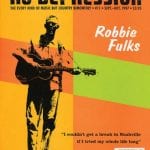Field Reportings from Issue #11
FIND THAT BAND
Find/Found:
Zeitgeist/Reivers
Here’s a new twist on the “Find That Band” theme: Instant Answer! We received the following query a couple months ago:
For your “Find That Band” segment, whatever happened to Austin’s the Reivers, formerly known as Zeitgeist? I loved these guys (and girls) back in my college days and was wondering what they’re doing now. Thanks.
–Dan Herrington
Nashville, TN
You came to the right place on this one, Dan. Very people saw Zeitgeist and the Reivers play more than me; I’d estimate I saw them close to 100 times from 1985 to 1991.
Singer-guitarist John Croslin has established a rising career as a producer, having worked with Matador Records band Spoon (with whom he recently toured as bassist for a brief stretch), Austin power-pop group the Wannabes, and several others. He also produced a collaborative single between the Old 97’s and Waylon Jennings that has yet to be released.
Singer-guitarist Kim Longacre has been busier as a mother than as a musician since the Reivers played their final gig in October 1991. However, she has been singing occasionally with Larry Seaman (formerly of Austin bands the Standing Waves and The Last Straw). She’s also paired with Robbie Jacks on a track from the Jo Carol Pierce tribute album Across The Great Divide, and has a track of her own on another recent compilation album of Austin artists.
Bassist Cindy Toth spent a couple years playing in a psychedelic guitar outfit called the Flying Saucers and an all-girl punk band called Wet. Last we heard, she was living in Madison, Wisconsin, and was more involved in the theater scene there than in music.
Drummer Garrett Williams moved for a while to Florida but recently returned to Austin. To our knowledge, he hasn’t played music at all since the Reivers split up.
–Peter Blackstock
Not Found:
Franklin Hugh Trainor
Sorry to report to last issue’s letter-writer Peter Williams that we received no responses to his query in ND #10 (July-Aug. ’97) for more information on songwriter Franklin Hugh Trainor. If anyone out there knows anything about this guy, responses are certainly still welcome (e-mail us at info@nodepression.com, or write us at P.O. Box 31332, Seattle, WA 98103).
ELVIS FACTOID
Upon fact-checking the little details in David Cantwell’s exemplary essay on Elvis Presley in this issue, we happened upon what appears to be a remarkable discrepancy in several reference books over a very significant date in 20th-century popular music history. The question seems simple enough for any Rock Critic Jeopardy flunkie: What was the date of Elvis Presley’s only appearance on the Grand Ole Opry? Yet we consistently found two conflicting answers in the many books we checked: Sept. 25, 1954, and Oct. 2, 1954.
The most concrete confirmation comes from Pickin’ and Singin’ News, a fan newspaper that was edited in the 1950s by Opry founder George D. Hay. Paul Kingsbury of the Country Music Foundation reports that a copy of the paper’s Oct. 15, 1954, edition contained in the CMF’s files states: “Elvis Presley, whose record of ‘Blue Moon of Kentucky’ and ‘That’s All Right’ is doing great, made his first appearance on the Grand Ole Opry Saturday night, Oct. 2.”
Other sources citing the Oct. 2 date include Peter Guralnick’s 1994 biography Last Train To Memphis: The Rise Of Elvis Presley, which gives a detailed account of the evening’s events via interviews with Presley’s then-manager Sam Phillips, guitarist Scotty Moore’s wife Bobbie and others who were there that night. Guralnick also states that after the Opry — on which Elvis performed one song, “Blue Moon of Kentucky”, and got a lukewarm reception with the audience — Presley and his band went over to Ernest Tubb’s Record Shop and performed on the Midnight Jamboree. This assertion is corroborated by Ronnie Pugh’s 1996 biography Ernest Tubb: The Texas Troubadour. And Colin Escott and Martin Hawkins’ 1991 book Good Rockin’ Tonight: Sun Records And The Birth of Rock ‘n’ Roll states that “Presley performed Blue Moon of Kentucky on the 10:15-10:30 segment of the Opry on Oct. 2, 1954.”
Assuming, then, that Oct. 2 is the correct date, the following sources have incorrectly listed it as September 25:
The Rolling Stone Encyclopedia of Rock & Roll;
The Ultimate Elvis: Elvis Presley Day By Day, by Patricia Jobe Pierce;
Chet Hagan’s 1989 book Grand Ole Opry, written in conjunction with the Opry’s 65th anniversary in 1990;
Albert Goldman’s biography of Elvis.
Other interesting details popped up along the path of researching the subject. Nick Tosches’ 1977 book Country: The Twisted Roots Of Rock ‘n’ Roll. claims Presley played both “Blue Moon Of Kentucky” and “That’s All Right”, while nearly all other sources insist that only “Blue Moon” was performed. And Lee Cotton’s 1985 book All Shook Up: Elvis Day By Day claims that Elvis played at the Eagle’s Nest club in Memphis with the Tiny Dixon Band on September 25; however, Cotton’s book has no listing whatsoever for anything of note in Presley’s career having happened on October 2.
A source at the Grand Ole Opry pointed out that, because Presley performed as a guest during Hank Snow’s segment of the show, his name would not have appeared in the Opry’s record books, which commonly have not listed every single guest performer who has performed within the sets of other Opry regulars.
To make a long story short, we refer to a passage from Down At The End of Lonely Street: The Life And Death Of Elvis Presley, a new biography Peter Harry Brown and Pat H. Broeske: “Over the years there have been conflicting accounts regarding Elvis’ Opry show.” Indeed — for instance, exactly when it happened.
–Peter Blackstock




